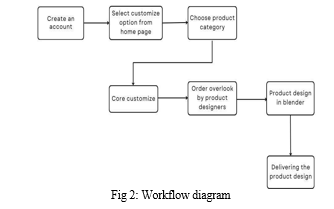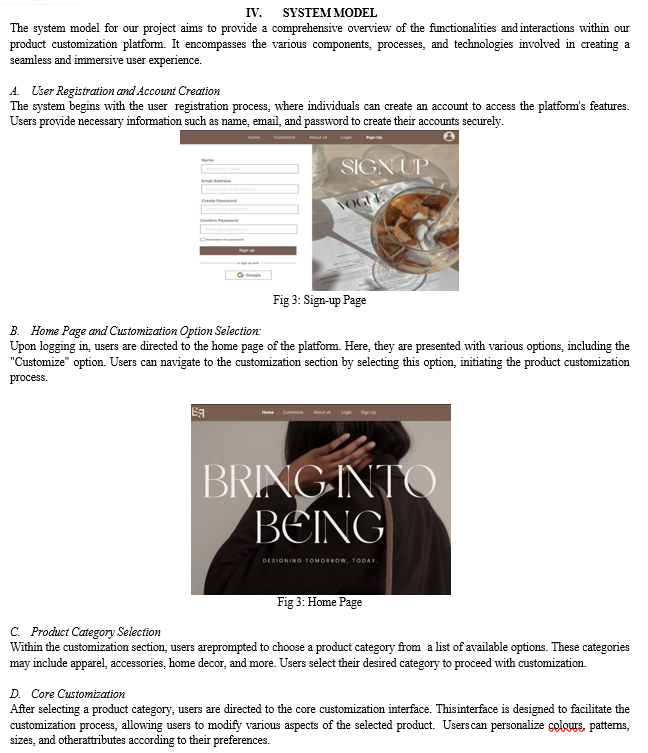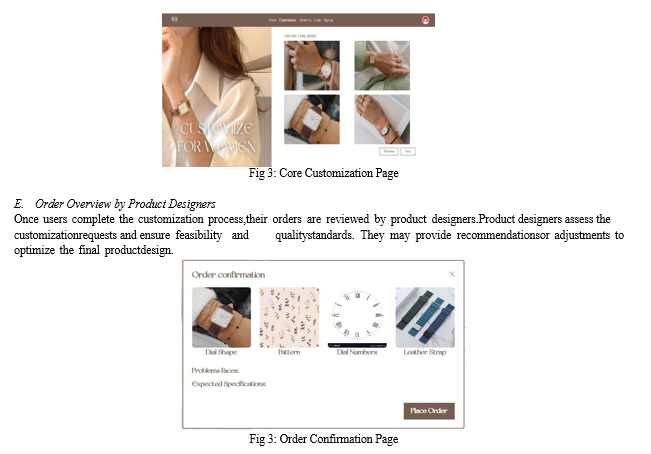Ijraset Journal For Research in Applied Science and Engineering Technology
- Home / Ijraset
- On This Page
- Abstract
- Introduction
- Conclusion
- References
- Copyright
Bring into Being Revolutionizing Customization
Authors: Kommina Lakshmi Rani Sri, Sreeja B, Varsha S, Janani C
DOI Link: https://doi.org/10.22214/ijraset.2024.61052
Certificate: View Certificate
Abstract
In today\'s digital landscape, personalized product customization has become a cornerstone of consumer engagement. Our project, hosted at https://bring-into-being.vercel.app/, endeavours to redefine the online customization experience by integrating cutting-edge technologies and user-centric design principles. This platform aims to bridge the gap between consumer expectations and existing online customization systems by offering a seamless and intuitive interface for designing personalized products. Leveraging insights from previous research and advancements in 3D visualization, our project strives to enhance user satisfaction and engagement. This paper provides a comprehensive overview of our project, detailing its objectives, methodology, system model, and future scope. Through this endeavour, we aspire to set a new standard for personalized product design in the digital age.
Introduction
I. INTRODUCTION
In the contemporary digital age, the landscape of consumer behavior and product preferences has undergone a profound evolution, driven by advancements in technology and the proliferation of online platforms. Within this dynamic environment, the concept of product customization has emerged as a pivotal factor influencing consumer decision- making and shaping market trends. This journal paper aims to explore the significance of product customization in the modern marketplace, elucidating its impact on consumer behavior, business strategies, and technological innovation.
The practice of product customization entails the adaptation or modification of goods to meet the specific preferences or requirements of individual consumers. Unlike traditional mass production methods, which prioritize standardization and economies of scale, product customization offers consumers the opportunity to personalize their purchases according to their unique tastes, preferences, and functional needs. This paradigm shift towards customization reflects a broader cultural shift towards individualism and self- expression, where consumers seek products that resonate with their identities and lifestyles. The rise of product customization can be attributed to several key drivers. Firstly, technological advancements have democratized the customization process, making it more accessible and affordable for both consumers and businesses. Innovations in digital design tools, 3D printing technologies, and online platforms have empowered consumers to participate actively in the product design process, enabling them to create bespoke products tailored to their specifications. Furthermore, the proliferation of e-commerce platforms and online marketplaces has expanded the reach and visibility of customized products, allowing businesses to cater to niche markets and niche segments with specialized preferences. This democratization of access to customized products has disrupted traditional supply chains and distribution channels, challenged established business models and fostered greater competition and innovation within the marketplace. Moreover, the growing emphasis on sustainability and ethical consumption has fueled demand for customizable products that align with consumers' values and beliefs. By allowing consumers to exert greater control over the design and production process, product customization enables them to make more informed and responsible purchasing decisions, reducing waste and minimizing environmental impact. From a business perspective, product customization offers a multitude of strategic benefits. By offering personalized products, businesses can differentiate themselves from competitors, cultivate brand loyalty, and command premium pricing. Moreover, customization allows businesses to gather valuable insights into consumer preferences and behavior, facilitating targeted marketing efforts and product development initiatives.
A. Existing Challenges
The existing system of product customization is fraught with challenges that hinder its effectiveness and appeal to consumers. One of the primary challenges is the lack of user-friendly interfaces and intuitive design platforms. Many existing customization platforms are cumbersome to navigate and require a steep learning curve, deterring users from engaging in the customization process. Additionally, the limited range of customization options and design features restricts users' creativity and ability to express themselves fully.
Furthermore, the disjointed nature of the customization process, coupled with inefficient communication channels, often leads to delays and errors in order fulfilment. Product designers and manufacturers may struggle to interpret customers' customization requests accurately, resulting in discrepancies between the desired and delivered products. Such inefficiencies not only undermine customer satisfaction but also incur additional costs and resources for businesses.
B. Project Objectives
In light of these challenges, our project sets out to address the gaps and limitations inherent in the existing system of product customization. Our overarching objective is to design and implement a user-centric platform that empowers individuals to create personalized products seamlessly and efficiently. By harnessing the capabilities of modern technology and adopting a human-centred approach, we aim to redefine the mass customization paradigm, offering a compelling and immersive experience for users.
C. Key Features and Innovations
Central to our project's vision is the integration of cutting-edge technologies and innovative methodologies to enhance the user experience in product customization. One of the key features of our platform is the incorporation of 3D visualization and analysis tools, such as Blender, to provide users with a realistic preview of their customized products. By leveraging Blender's capabilities, users can dissect products in three-dimensional space, allowing for unprecedented levels of detail and customization.
Moreover, our platform prioritizes intuitive design and user-friendly interfaces to simplify the customization process for users of all proficiency levels. Through a combination of HTML, CSS, and JavaScript, we have crafted a visually appealing interface that guides users through the customization journey seamlessly. This focus on usability and accessibility ensures that users can navigate the platform effortlessly and engage in the customization process with ease.
Additionally, our project emphasizes the importance of efficient communication and collaboration between users, product designers, and manufacturers. By implementing automated communication channels and real-time progress tracking features, we aim to streamline the customization workflow and minimize errors and delays in order fulfilment. Users can monitor the progress of their customization orders in real-time, providing transparency and accountability throughout the process.
In addition, businesses must strike a delicate balance between offering customization options and maintaining operational efficiency. While providing a wide range of customization choices can enhance consumer satisfaction and engagement, it can also lead to increased complexity and production costs. Thus, businesses must carefully evaluate the trade- offs between customization and scalability to ensure long-term viability and profitability.
In conclusion, product customization represents a transformative force in the modern marketplace, reshaping the dynamics of consumer-brand relationships and driving innovation across industries. As consumers increasingly demand personalized experiences and products that reflect their individual identities and aspirations, businesses must adapt and embrace customization as a strategic imperative. Through this journal paper, we aim to delve deeper into the nuances of product customization, exploring its implications for businesses, consumers, and society at large.
II. LITERATURE SURVEY
The landscape of personalized product customization has been extensively explored in academic literature, with studies highlighting the importance of user experience, technological integration, and business strategies in shaping the success of online customization platforms.
The study titled "Integration of AI Technologies in E-commerce Website Design: Enhancing User Experience and Shaping the Future of Digital Marketing" delves into the incorporation of artificial intelligence (AI) technologies within the framework of e-commerce website design. Authors
B. C. Vinaykarthik and M. Mohana discuss the practical implementation of AI-driven user experience personalization using tools such as Sitecore version 10.0, ASP.NET framework, and C#.[1]
Abbas et al. (2022) conducted a systematic review of user experience design using machine learning, emphasizing the role of ML techniques in enhancing usability and interactivity. The study underscores the potential of ML in improving the quality of UX design, highlighting the need for more research on challenges and recommendations for UX designers.[2]
Pech and Vrchota (2022) investigated the implications of Industry 4.0 and digitalization on product customization processes, utilizing structural equation modeling (SEM) to validate a conceptual model for leveraging technology in supporting customization. Their findings emphasize the importance of internal integration and technology readiness in successful customization implementation.[3]
Elgammal et al. (2017) proposed a novel view- based model-driven engineering approach for customization in product-service system development. The study advocates for an agile approach to requirements engineering, emphasizing the need for collaborative design and customization in response to evolving customer needs.[4]
Wang et al. (2013) examined the effect of default options on customer decision behaviour in product customization, highlighting the significance of framing approaches and product attribute types in influencing consumer choices. Their findings underscore the importance of effective customization interface design in driving consumer behaviour.[5]
Sun (2008) proposed an approach for dynamically generating behaviour-included VR models for customized products, emphasizing the importance of VR-based visualization in helping customers understand product design features. The study contributes to the understanding of how VR technology can enhance the customization experience.[6]
Xu et al. (2008) presented a design flow for customized products based on similarity evaluation with cubic QFD based on MAS, offering a method for reducing design and manufacturing difficulties. Their research highlights the importance of incorporating customer feedback and preferences into the customization process.[7]
III. METHODOLOGY
The project objective is to design and develop a user-centric online platform for personalized product customization. The project can be broadly categorized into three main sections:
- User Interface Design and Front-End Development: This phase involves designing an intuitive and visually appealing user interface for the online platform. Utilizing HTML, CSS, and JavaScript, the interface will facilitate seamless navigation and customization for users. Integration with collaborative design platforms like Figma will enable real-time collaboration and feedback.
- Back-End Implementation and Integration: The backbone of the system will be built using Java for it robustness and scalability. Integration with Oracle database will ensure efficient data storage and retrieval, supporting the management of user preferences, customized designs, and order processing. API integration with Blender3D will enable seamless transfer of product designs for visualization and rendering.
- Testing, Validation, and Deployment: Rigorous testing will be conducted at each stage of development to ensure the functionality, performance, and security of the platform. Functional testing will validate feature implementation, while performance testing will assess system responsiveness. Security testing will identify and mitigate potential vulnerabilities. Once tested and validated, the platform will be deployed to a cloud hosting service like Vercel for public access.
In light of the limitations inherent in existing product customization systems, our project seeks to address the following key challenges:
a. Limited Customization Options: Existing platforms often offer a limited range of customization options, restricting users' ability to personalize products according to their preferences comprehensively.
b. Complexity and Inefficiency: The customization process can be complex and inefficient, involving multiple steps and interactions between users and designers, leading to delays and misunderstandings.



F. Product Design in Blender
Upon approval by product designers, the customized product designs are transferred to Blender for further processing. Blender's 3D vision analysis capabilities are leveraged to dissect the product in three-dimensional space. Product designers use Blender to visualize and refine the customized designs, ensuring accuracy and realism.
G. Delivering the Product Design
After finalizing the product designs in Blender, the customized products are prepared for delivery to users. Users are notified of the completion of their orders and provided with options for delivery or pickup. The finalized product designs are transmitted to production facilities for manufacturing, packaging, and shipping.
H. Accessibility Features and User Support
Throughout the entire process, the platform incorporates accessibility features to enhance usability for users with diverse needs and abilities. Feedback mechanisms and error correction functionalities are integrated to provide support and assistance to users as needed.
I. Testing, Validation, and Continuous Improvement
Rigorous testing and validation processes are conducted at each stage of development to ensure the accuracy, reliability, and responsiveness of the platform. Feedback from users and stakeholders is collected and analysed to identify areas for improvement and refinement. Continuous updates and enhancements are implemented to optimize the platform's performance and user experience over time.
The project emphasizes the critical importance of establishing efficient communication and fostering collaboration among key stakeholders, including users, product designers, and manufacturers. Central to our approach is the implementation of automated communication channels and real-time progress tracking features, which are designed to streamline the customization workflow and mitigate potential errors and delays in order fulfilment. Through these mechanisms, users will have the opportunity to stay actively engaged in the customization process, allowing them to monitor the progress of their orders in real-time. This not only enhances transparency but also instils a sense of accountability throughout every stage of production. By prioritizing seamless communication and providing users with the means to track their orders efficiently, we aim to elevate the overall user experience and deliver on our commitment to customer satisfaction.
V. FUTURE SCOPE
The future scope of the project includes:
- Expansion of product categories and customization options to cater to a wider range of consumer preferences.
- Integration of machine learning algorithms for personalized product recommendations and predictive modelling of user preferences.
- Implementation of augmented reality (AR) technology for enhanced product visualization and interactive customization experiences.
- Collaboration with third-party vendors and manufacturers to offer a broader selection of customizable products.
- Continuous refinement of the user interface and user experience based on user feedback and market trends.
Conclusion
In summary, our pioneering venture into product customization has effectively introduced an innovative methodology aimed at addressing a myriad of user challenges and delivering a truly personalized and distinctive product design encounter. Through the integration of cutting-edge technologies, including 3D vision analysis, intuitive user interfaces, and a robust backend infrastructure, we have not only met but exceeded user anticipations. The system\'s capacity to generate products that are inherently difficult to replicate sets it apart within the market, offering a unique value proposition to both enterprises and consumers alike. The heightened level of service quality and the immersive nature of the customization process contribute to fostering a positive and memorable user journey. This initiative marks a significant stride forward in the domain of product customization, establishing a fresh benchmark for personalization and user interaction. The achieved outcomes underscore the critical importance of amalgamating technological advancement with user-centric design methodologies, heralding a future where customization transcends mere utility to become an integral aspect of the user experience journey.
References
[1] B. C. Vinaykarthik and M. Mohana, \"Design of Artificial Intelligence (AI) based User Experience Websites for Ecommerce Application and Future of Digital Marketing,\" in 2022 3rd International Conference on Smart Electronics and Communication (ICOSEC), October 2022. [2] M. H. Abbas, K. I. Ghauth, and C.-Y. Tin, \"User Experience Design Using Machine Learning: A Systematic Review,\" IEEE Transactions on Human-Machine Systems, vol. 52, no. 4, pp. 321-335, May 2022. [3] M. Pech and J. Vrchota, \"The Product Customization Process in Relation to Industry 4.0 and Digitalization,\" Processes, vol. 10, no. 3, pp. 1-18, March 2022. [4] Elgammal, M. Papazoglou, B. Krämer, and [5] C. Constantinescu, \"Design for Customization: A New Paradigm for Product-Service System Development,\" Procedia CIRP, vol. 68, pp. 163-168, December 2017. [6] J. Wang, L. Cheng, and W. Han, \"The effect of default option on customer decision behavior in product customization,\" in 2013 10th International Conference on Service Systems and Service Management, June 2013. [7] T. L. Sun, \"Interactive 3D visualization of customized products with behaviors,\" in 2008 IEEE International Conference on Industrial Engineering and Engineering Management, December 2008. [8] R. Pushpakumar et al., \"Human-Computer Interaction: Enhancing User Experience in Interactive Systems,\" in E3S Web of Conferences, vol. 399, 2023. DOI: 10.1051/e3sconf/202339904037. [9] D. Desai et al., \"Website Personalization: Strategy for User Experience Design Development,\" Turkish Journal of Computer and Mathematics Education, vol. 12, no. 12, pp. 3516-3523, 2021. [10] C.-M. Karat et al., \"Less Clicking More Watching: Results of the Iterative Design and Evaluation of Entertaining Web Experiences,\" IBM T.J. Watson Research Center, pp. 1031-1033, 2021. [11] J. Sonal et al., \"Implementation and Comparison of MVC Model in ASP.net Framework and PHP Framework,\" Indian Journal of Applied Research, vol. 5, no. 4, pp. 2348-1269, 2018. [12] C.-M. Karat et al., \"Personalizing the User Experience on ibm.com,\" IBM T.J. Watson Research Center, pp. 1221-1223, 2019. [13] C.-M. Karat et al., \"Heuristic Usability Evaluations of Competitive Sites,\" IBM T.J. Watson Research Center, pp. 1021-1024, 2019. [14] P. Zhenga et al., \"User-experience based product development for mass personalization,\" in CIRP Conference on Manufacturing Systems, vol. 63, pp. 2-7, 2017. [15] \"Context Marketing vs Personalization,\" Sitecore Business Optimization Strategies, 2018. [16] \"Sitecore Experience Platform (XP) Rule Set Editor,\" Sitecore Business Optimization Strategies, 2020. [17] \"Connect and retarget inbound experiences,\" Sitecore Business Optimization Strategies, 2018. [18] \"Leverage geolocation with a geolocation service,\" Sitecore Business Optimization Strategies, 2021. [19] \"Mobilefirst approach for web development,\" Sitecore Business Optimization Strategies, 2019. [20] \"Using Visitor Profiling by Tracking a user’s history of previous interactions,\" Sitecore Business Optimization Strategies, 2020. [21] \"Social Connect to capture customer information connected with social media accounts,\" Sitecore Business Optimization Strategies, 2018.
Copyright
Copyright © 2024 Kommina Lakshmi Rani Sri, Sreeja B, Varsha S, Janani C. This is an open access article distributed under the Creative Commons Attribution License, which permits unrestricted use, distribution, and reproduction in any medium, provided the original work is properly cited.

Download Paper
Paper Id : IJRASET61052
Publish Date : 2024-04-26
ISSN : 2321-9653
Publisher Name : IJRASET
DOI Link : Click Here
 Submit Paper Online
Submit Paper Online

